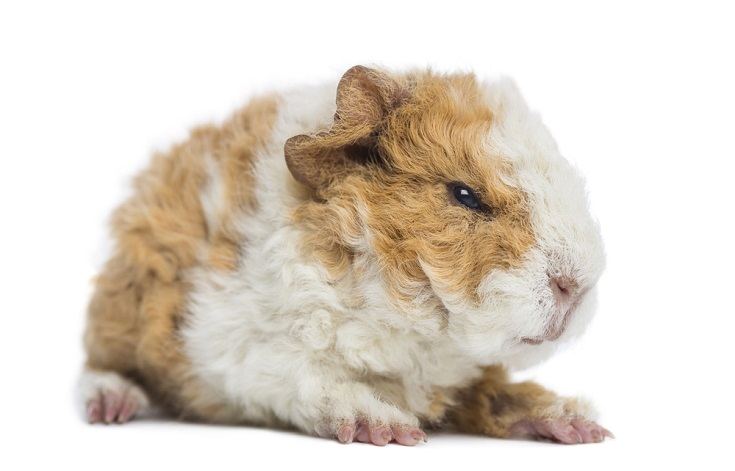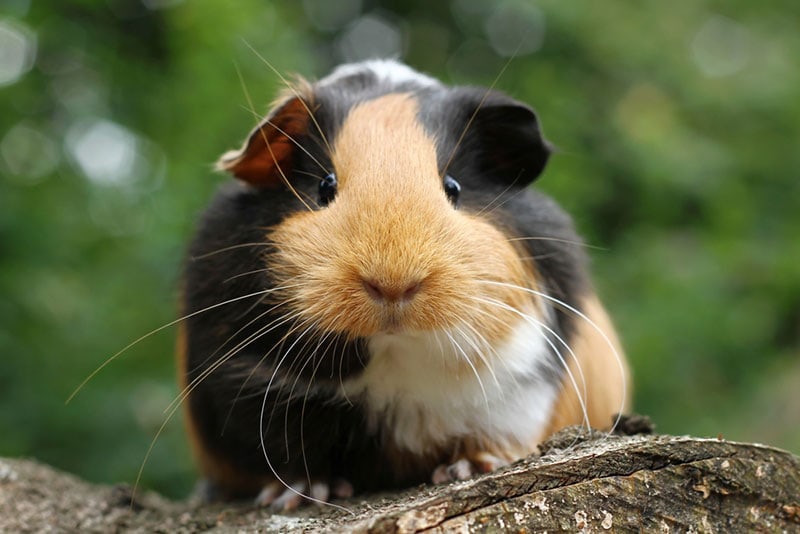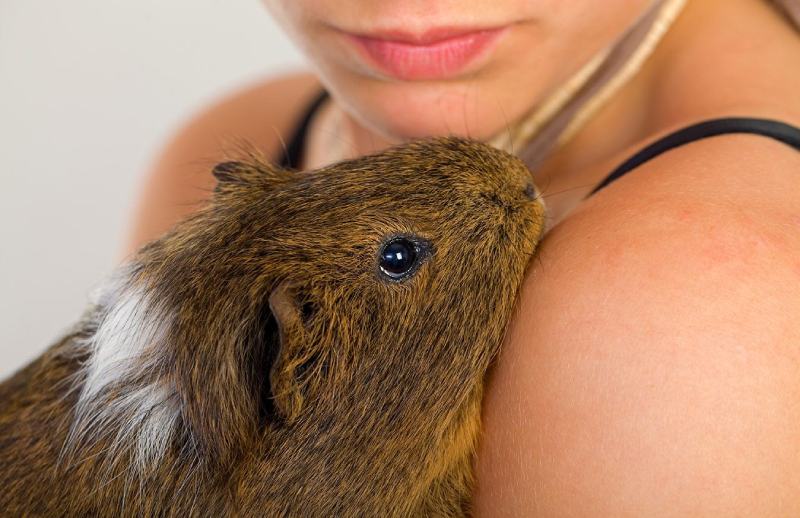Alpaca Guinea Pig: Pictures, Lifespan, Behavior & Care Guide

Updated on

Click to Skip Ahead
The Alpaca guinea pig is distinctive and recognizable for its long, curly hair. It is a rare breed and while it is highly prized by some guinea pig owners, its coat does require a lot of care, which puts some owners, especially novice owners, off. Like all guinea pigs, it does better when kept with others of its kind, and the Alpaca guinea pig can become depressed and anxious if kept on its own.
Otherwise, the Alpaca guinea pig is considered a good breed because it tends to be sweet-natured and with regular handling, this breed will usually become quite close to its owner.
Breed Overview
| Size: | Medium |
| Weight: | Up to 2.5 pounds |
| Lifespan: | 4 – 6 years |
| Similar Breeds: | Peruvian, Texel |
| Suitable for: | Experienced guinea pig owners who want an unusual breed |
| Temperament: | Sweet, affectionate, sociable |
The most obvious physical feature of the Alpaca guinea pig is its long, curly coat. The coat does mean that the Alpaca has higher care requirements than other breeds, as a lack of good coat maintenance can lead to matting and knotting. For this reason, the Alpaca is not usually recommended for beginners, but potential owners willing to put in the time to research the breed and its requirements will find a sweet guinea pig that enjoys their company and has a lot of character.
Characteristics
How Much Do These Guinea Pigs Cost?
The Alpaca guinea pig is quite a rare breed, and this rarity means that it costs more than common breeds. Expect to pay around $50 per guinea pig. Because they are sociable, herd animals, you should house at least two together, which means paying more. Although you may find guinea pigs in local pet stores, you will more likely have to go directly to a breeder to find a specific breed like the Alpaca.
Although this is a rare breed, it does have higher care requirements than other guinea pig breeds, which means that some owners may give them up because they weren’t aware of the commitment required. Therefore, you might be able to find an Alpaca guinea pig in rescues or shelters.
There are additional costs to consider when buying any guinea pig. You will need a hutch as well as a run where your Cavie can exercise. You will also need bedding, toys, and food.

Temperament & Intelligence of the Alpaca Guinea Pig
The Alpaca guinea pig is known to be a calm and peaceful guinea: one that will become accustomed to handling. However, as with any breed, it depends more on the character of the individual, as well as how well-socialized the guinea pig is.
Do These Guinea Pigs Make Good Pets?
For the right owner, Alpaca guinea pigs can make excellent pets. They tend to be good-natured and gentle. They are intelligent to be litter trained and they are big enough to be safely handled without too much fear of causing injury. However, they do have long coats that take a lot more care than short coats, which means they are higher maintenance than your average guinea, so they may not be ideal for all potential owners.
Does This Guinea Pig Get Along with Other Pets?
Guinea pigs shouldn’t be left unattended with other animals, like cats and dogs. They are small and they tend to run when startled, so they can trigger the hunting instinct in even the calmest of household pets. However, they will get along with other guinea pigs, and it is generally recommended that these sociable little animals are kept in pairs or small groups.
Things to Know When Owning an Alpaca Guinea Pig:
Alpaca guinea pigs have long, wavy hair, but they can come in any color and with any marking, which means there is a good variety in the appearance of these Cavies. In terms of their character, they make good pets, but you will need to learn how to properly maintain the coat to ensure your Alpaca guinea pig stays healthy.
Food & Diet Requirements
Approximately 85% of a guinea pig’s diet should be made up of hay or grass. Not only does this meet the high fiber requirement of the species but the constant gnawing grinds a guinea pig’s teeth down. The teeth grow constantly and if a guinea pig doesn’t control the length of the teeth through grinding and gnawing, they get too long and will need cutting, typically by a vet.
Ensuring the guinea pig gets enough vitamin C is also important, and one way to achieve this is by giving commercial pellets each day. You can also feed fresh greens, but you need to check that the vegetables you feed are considered suitable for guinea pigs. Alpaca guinea pigs do not have any special dietary requirement that differs from a general guinea pig diet.
Always provide access to fresh water, either in a bottle or a bowl, and ensure that your Cavie can get to the water whether they are in the hutch, in the run, or on your lap.
Habitat & Hutch Requirements
You can house guinea pigs outdoors as long as you have the appropriate climate. This can be beneficial if you live in a busy house where your Cavie won’t be able to get peace and quiet. Use a plastic bottom indoor cage or a wooden hutch and ensure it has a separate sleeping area as well as an area for feeding and somewhere your guinea pig can use as a toilet area.
Indoors, the hutch needs to be out of the way of drafts and ideally not in a high-traffic or high-noise area.
As well as a hutch, you will need to provide a run, which can be indoors or outdoors. Your guinea will appreciate being allowed to run in the garden where they can munch grass and weeds but you need to be careful of predators and don’t put your guinea pig outside in extreme weather conditions. Ensure you provide a cage that measures at least 4 feet by 2 feet for two guinea pigs.
Exercise & Sleeping Needs
Ideally, you should provide three or four hours of free time, running out of the cage either in a run or a room that has been guinea pig-proofed.
Guinea pigs do chew, and they will likely try and chew anything that looks appealing. This can include wires, as well as wooden furniture, so you will need to choose a room carefully and then ensure that items are picked up and placed out of the way of your Cavie.
Exercise wheels and balls are not appropriate for Guinea pigs. Their short legs and muscular backs prevent them from being able to safely use these types of items, so even if you see balls or wheels advertised as being safe for guinea pigs, you should avoid them.
Toys can provide enrichment and help prevent boredom. Guinea pigs love toys they can chew as well as those they can hide in. You may even be able to teach your Cavie to play with a ball.
Training
Guinea pigs can be trained, although it will take patience and persistence. At the very least, you should train your Cavie not to bite when you handle them, and you can also train them to use a litter tray which makes cleaning out the hutch a lot easier.
After your guinea pig has had a few days to settle in and get used to its new surroundings, you should start training them to be handled. Fortunately, guinea pigs love food, and you can use this to your advantage. Have a favorite treat in your hand and start by offering the treat, on your hand, in your Cavie’s cage. Hold your hand out flat with the food in your palm. Do this a few times a day, making sure you talk to them while you’re doing it. When your guinea pig is used to taking food out of your hand, you can start offering something like a basil leaf that you can hold in front of them, and then gently pat their head. Take things slowly and only progress to the next step when your guinea pig has gotten used to the last one.
It is also possible to litter train a guinea pig. Determine where it prefers to pee and poop in the cage and then start putting a litter tray in that area. You can also pick up some of the poop from the cage and put it in the tray. Reward your guinea pig when it does pee or poop in the tray and once they have got the hang of using the tray, you can try removing it from the cage, for example when they exercise, and have them use the tray there, too.
Grooming
You will need to groom an Alpaca guinea pig every day to help prevent matting and knotting of their incredible coat. Be gentle when brushing and always brush down the hair. Look for dirt and spot-clean any feces or other debris out of the coat.
Nail trimming should be done monthly, although if yours is an active guinea pig that has some time on hard abrasive surfaces, you may not need to trim this often.
Guinea pigs don’t typically like having their nails clipped, and the process is easier and safer with two of you: one to hold the pig and the other to do the clipping. Take things slowly and take breaks between clipping sessions, or you can cause stress and it will become even more difficult to trim the nails next time.
Lifespan and Health Conditions
Unfortunately, guinea pigs are somewhat prone to certain illnesses and conditions, and the Alpaca guinea pig is especially prone to matted hair and, if not kept clean, fly strikes. Pneumonia and diarrhea are two of the most common illnesses that the little rodents will likely suffer.
- Diarrhea
- Scurvy
- Pneumonia
- Respiratory Infections
- Urinary Infections
Male vs Female
Male guinea pigs tend to live a little longer than sows, or female guinea pigs, and this is especially true if the female breeds. Males are more confident, which can lead to improved handling. However, individual characteristics are more likely to determine the personality of a guinea pig than its gender.
3 Little-Known Facts About Alpaca Guinea Pigs
1. Alpaca Guinea Pigs Are Quite Rare
Although it is usually possible to find breeders that do have Alpaca guinea pigs, they are still considered quite rare. Although their coats are beautiful, they also require a lot of care and maintenance which puts some owners off and this means that breeders tend to concentrate on the more popular breeds.
2. They Originate from Peruvian Guinea Pigs
The Alpaca guinea pig is often mistaken for the Texel guinea pig because of its coat, but they are in fact descended from Peruvian guinea pigs. Peruvian guinea pigs have the same long coat, but it tends to be straight, unlike the curly coat of the Alpaca.
3. They Are Named After Alpacas
It’s not that surprising to learn that Alpaca guinea pigs are named after the camelid mammal called the alpaca. Its long, curly coat looks very similar to that of the South American animal.
Final Thoughts
The Alpaca guinea pig is an uncommon breed of guinea that is recognizable for its long, curly coat. The coat does require a lot of maintenance, which typically means it needs daily brushing to avoid matting and knotting. However, the breed is also known for being gentle and sweet-natured, so potential owners who have the time and inclination to learn how to effectively groom this breed will enjoy the benefit of a good pet.
As with any guinea, you should start handling the breed when it is young and keep up daily handling to ensure a sociable pet.
Featured Image Credit: Eric Isselee, Shutterstock










